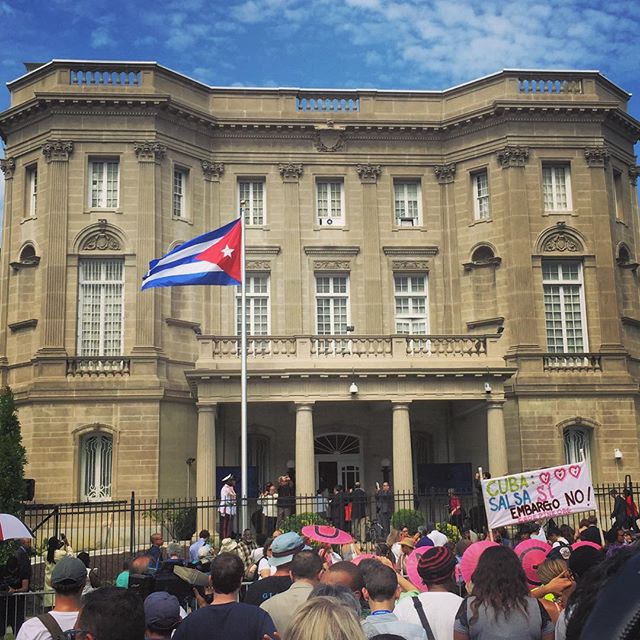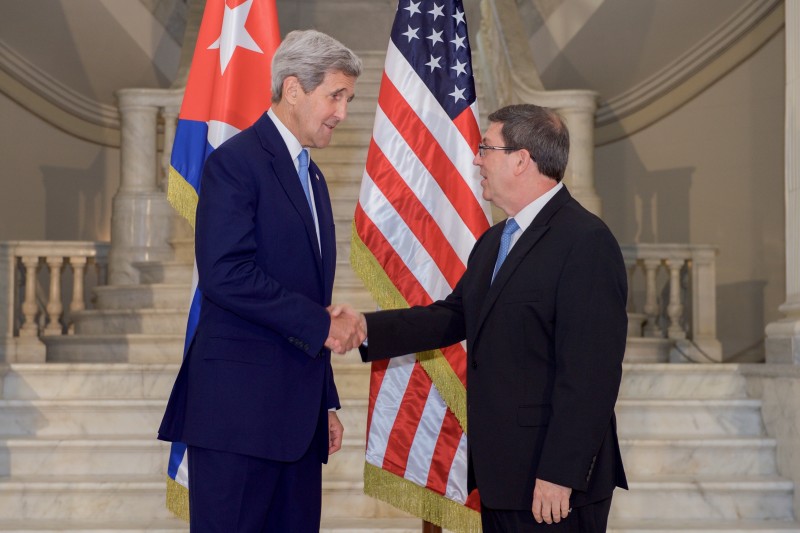
Washington, United States. 20th July 2015. People gather at the Cuban embassy to witness the Cuban flag being raised in Washington D.C. after 54 years. Copyright Demotix.
A friend once told me that every Cuban will always remember what she or he was doing on December, 17, 2014. I certainly do. I have a clear recollection of the tears welling up in my eyes, my hands pressed over my mouth, literally to stop me from speaking, how I held my breath: because by the time presidents Barack Obama and Raúl Castro made the announcement I thought anything I did would ruin that moment forever.
So I stayed very quiet. How long did it take them to present the official statements? I have no idea. It felt like more than 50 years, and painful.
For Cubans born, like me, in the late ‘80s, the first encounter with the United States was through the second-hand experience of emigration. My best friend in elementary school won the visa lottery and disappeared all of a sudden, leaving me with lots of questions no one dared to answer, because de eso no se habla[1]. Just a year later, it was my very own uncle who left the country in a rickety raft along with 17 other men right before the so called “rafters crisis”. And I started hearing more and more people saying that que el que se va, se muere[2].
One way or the other, those who left died in our minds. Even those who called regularly on the phone seemed so far away in our imaginations that we felt we had lost them forever, a feeling intensified by the sense of being trapped on a small landmass surrounded by the sea.
In May 2013 I traveled for the first time to Washington, DC, to participate in the Latin America Studies Association Congress, an event in which the Cuba section has hundreds of affiliates. After the decline of people-to-people exchanges during the Bush years, the Obama administration’s efforts to bring them back allowed under-thirty professionals like me to share our insights about Cuban reality in a variety of academic spaces. For me, however, the most important part of that first trip to the US was the opportunity it gave me to experience a historic political confrontation from the point of view of people living “on the other side”.
So on a rainy night in June 2013, after twenty long years, I was finally able put a physical image to my uncle’s house, a wooden dwelling in the middle of a trailer park in Miami, where he sits out at night tending his barbecue and telling stories about what it’s like to be a balsero[3].
In 2014, I was awarded a Nieman fellowship at Harvard University, and moved to Cambridge, Massachusetts. I had few hopes, and lots of fears. But instead of the caricatural, black-and-white image portrayed by Cuban national media, I encountered profound respect from Americans toward my beloved country, the same kind of respect showed in US national opinion polls that provided the impetus for the 18 months of secret negotiations between the two countries leading up to the official announcement last December. And that gave me hope. But I also met people who believed that American democracy should or could be exported to Cuba, without acknowledging our long history of nationalism and independence.
On July 20, the Cuban flag was raised over the newly re-opened Cuban embassy in Washington, DC. And yesterday, August 14, US Secretary of State John Kerry was in Havana to oversee a similar ceremony at the US embassy in Havana. After 54 years, the flags of the US and Cuba fly once more over their respective embassies in each other's country. With the restoration of full diplomatic relations, we are witnessing a new era in Cuba. Although political differences persist, for the first time in my life there isn’t a specific enemy against whom we're expected to fight at all costs.
But the future of relations between our countries will depend on others’ ability to allow Cuba change at its own pace. The change must come from Cubans themselves, emigrants included.
In December 2014 I went back to my uncle’s place. “What do you think the new about Cuba-US affairs?” I asked him, with the combination of skepticism and hope the harsh economic crisis of the ‘90s taught us.
“I’m not a politician,” my uncle said, “I’m just a survivor. . . . But still, maybe this is a sign. It’s time to go back home.”

U.S. Secretary of State John Kerry meets with Cuban Foreign Minister Bruno Rodríguez in Havana, Cuba, on August 14, 2015, as part of his trip to re-open the U.S. Embassy in Cuba. Copyright Demotix.
[1] “We don´t talk about ´it´”
[2] The people who left, they symbolically die
[3] Rafter







